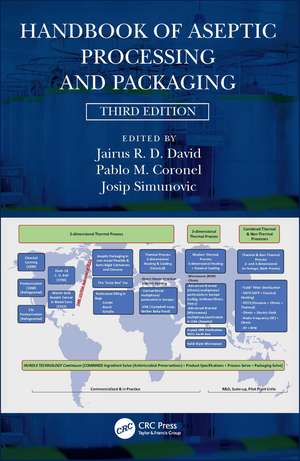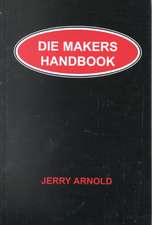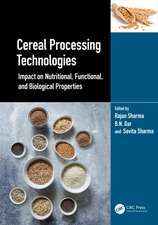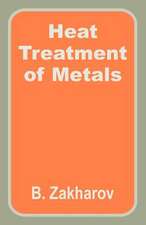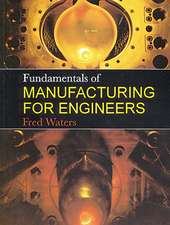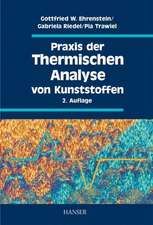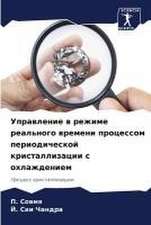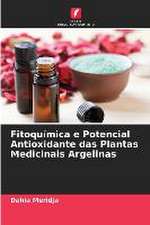Handbook of Aseptic Processing and Packaging
Editat de Jairus R. D. David, Pablo M. Coronel, Josip Simunovicen Limba Engleză Hardback – 8 sep 2022
In the third edition, the editors have compiled contemporary topics with information synthesized from internationally recognized authorities in their fields. In addition to updated information, 12 new chapters have been added in this latest release with content on
- Design of the aseptic processing system and thermal processing
- Thermal process equipment and technology for heating and cooling
- Flow and residence time distribution (RTD) for homogeneous and heterogeneous fluids
- Thermal process and optimization of aseptic processing containing solid particulates
- Aseptic filling and packaging equipment for retail products and food service
- Design of facility, infrastructure, and utilities
- Cleaning and sanitization for aseptic processing and packaging operations
- Microbiology of aseptically processed and packaged products
- Risk-based analyses and methodologies
- Establishment of "validated state" for aseptic processing and packaging systems
- Quality and food safety management systems for aseptic and extended shelf life (ESL) manufacturing
- Computational and numerical models and simulations for aseptic processing
- Also, there are seven new appendices on original patents, examples of typical thermal process calculations, and particulate studies—single particle and multiple-type particles, and Food and Drug Administration (FDA) filing
The future of aseptic processing and packaging of foods and beverages will be driven by customer-facing convenience and taste, use of current and new premium clean label natural ingredients, use of multifactorial preservation or hurdle technology for maximizing product quality, and sustainable packaging with claims and messaging.
Preț: 1577.77 lei
Preț vechi: 1924.11 lei
-18% Nou
Puncte Express: 2367
Preț estimativ în valută:
301.90€ • 316.06$ • 249.81£
301.90€ • 316.06$ • 249.81£
Carte tipărită la comandă
Livrare economică 07-21 aprilie
Preluare comenzi: 021 569.72.76
Specificații
ISBN-13: 9780367724801
ISBN-10: 0367724804
Pagini: 702
Ilustrații: 85 Line drawings, color; 45 Line drawings, black and white; 64 Halftones, color; 70 Halftones, black and white; 149 Illustrations, color; 115 Illustrations, black and white
Dimensiuni: 178 x 254 x 41 mm
Greutate: 1.4 kg
Ediția:3rd edition
Editura: CRC Press
Colecția CRC Press
ISBN-10: 0367724804
Pagini: 702
Ilustrații: 85 Line drawings, color; 45 Line drawings, black and white; 64 Halftones, color; 70 Halftones, black and white; 149 Illustrations, color; 115 Illustrations, black and white
Dimensiuni: 178 x 254 x 41 mm
Greutate: 1.4 kg
Ediția:3rd edition
Editura: CRC Press
Colecția CRC Press
Public țintă
AcademicRecenzii
I am honored to have the privilege of endorsing this excellent handbook. This book provides comprehensive information on thermal processing and aseptic processing and packaging technology in a technical and practical manner. I, myself, own copies of the previous editions of the Handbook of Aseptic Processing & Packaging, which I refer to often in my field of work.
The Handbook of Aseptic Processing & Packaging describes the fundamentals of thermal processing and aseptic processing & packaging systems in great detail. This includes federal regulation and requirements for aseptic processing & packaging, the design of thermal & aseptic processing systems. There are also further explanations in regards to product filling, packaging equipment and technology, particulate & non-particulate fluids processing and aseptic packaging materials.
Not to mention, the new and expanded 3rd edition contains detailed notes on the microbiology of aseptically processed and packaged products, thermal process calculations, facility design, utilities requirements, cleaning & sanitization, and quality management for aseptic and ESL products.
I tremendously commend the authors for their brilliant efforts in developing this excellent new edition of the Handbook of Aseptic Processing & Packaging.
The book will be a very useful resource for academics, students, food product development, processing and manufacturing professionals in the industry.
Riaz Ahamadeen
VP of Quality/Food Safety & Regulatory for North America at Oatly AB.
The Handbook of Aseptic Processing & Packaging describes the fundamentals of thermal processing and aseptic processing & packaging systems in great detail. This includes federal regulation and requirements for aseptic processing & packaging, the design of thermal & aseptic processing systems. There are also further explanations in regards to product filling, packaging equipment and technology, particulate & non-particulate fluids processing and aseptic packaging materials.
Not to mention, the new and expanded 3rd edition contains detailed notes on the microbiology of aseptically processed and packaged products, thermal process calculations, facility design, utilities requirements, cleaning & sanitization, and quality management for aseptic and ESL products.
I tremendously commend the authors for their brilliant efforts in developing this excellent new edition of the Handbook of Aseptic Processing & Packaging.
The book will be a very useful resource for academics, students, food product development, processing and manufacturing professionals in the industry.
Riaz Ahamadeen
VP of Quality/Food Safety & Regulatory for North America at Oatly AB.
Cuprins
Foreword. Preface. Acknowledgments. Editors. Contributors. PART I Fundamentals and Frontiers, Framework for Regulations, and Marketing. 1 Aseptic Processing and Packaging: Fundamentals and Frontiers. 2 US Federal Regulations for Aseptic Processing and Packaging of Food. 3 The US Markets for Aseptically Processed and Packaged Products. PART II Science and Engineering Aspects of Aseptic Processing and Packaging Technologies. 4 Processing System and Thermal Process Design. 5 Thermal Processing Equipment for Heating and Cooling. 6 Flow and Residence Time Distribution for Homogeneous and Heterogeneous Fluids. 7 Thermal Process and Optimization of Aseptic Processes Containing Solid Particulates. 8 Aseptic Filling and Packaging for Retail Products and Food Service. 9 Aseptic Packaging Materials and Sterilants. 10 Aseptic Bulk Packaging. 11 Design of Facility, Infrastructure, and Utilities. 12 Cleaning and Sanitization for Aseptic Processing Operations. PART III Risk-Based Analyses for Attaining Validated State for Production of Commercially Sterile Shelf-Stable Products and Guidance for Quality Assurance, Microbiological Food Safety, and Regulatory Compliance. 13 Microbiology of Aseptically Processed and Packaged Products. 14 Risk-Based Analyses and Methodologies. 15 Establishing "Validated State" of Aseptic Processing and Packaging Systems. 16 Quality and Food Safety Management System (QFSMS) for Aseptic and ESL Manufacturing Companies. PART IV Frontiers and R&D Opportunities and Challenges. 17 Computational and Numerical Models and Simulations for Aseptic Processing. 18 Frontiers and Research and Development: Challenges and Opportunities. PART V Appendices. Appendix 1: United States History & Evolution. Appendix 2: Dr. William McKinley Martin—Father of Aseptic Canning. Appendix 3: Aseptic Filler Profiles. Appendix 4: Aseptic Contract Manufacturers in the United States. Appendix 5: Examples of Typical Thermal Process Design for Aseptically Processed Fluids and Purees. Appendix 6: Process Design and Microbial Validation of a Product with Large Particulates. Appendix 7: Process Design and Microbial Validation of a Product with Large Particulates of Multiple Types. Appendix 8: Thermal Processing Methods. Index.
Notă biografică
Jairus R. D. David, Ph.D., is a thought leader in the agro-food industry and an expert on food preservation science, food safety and quality. His industrial experience spans family-owned small companies and large corporations—highly regulated baby foods, infant formula, consumer-packaged goods, and food service. Jairus has worked with the food industry in developing microbiology and thermal processing food safety objectives and compliance for canning and aseptic processing for over 38 years, balancing applied research with process and quality optimization, and launch of innovative products. He has developed natural and clean label ingredients systems, especially antimicrobial preservatives for designing minimally-processed foods.
Jairus has co-authored several refereed papers, book chapters, and patents. He has also co-edited books on Aseptic Processing and Packaging (1st edition 1996, 2nd edition 2013, Russian translation, 2014), Antimicrobials in Food (2021). Jairus is adjunct faculty at the departments of Food Science & Nutrition at Mississippi State University at Starkville, Mississippi, University of Nebraska at Lincoln, Nebraska, and Iowa State University at Ames, Iowa.
Jairus is currently Principal Consultant at JRD Food Technology Consulting, LLC., Omaha, Nebraska. More information can be found at WWW.JRDFoodTech.com. He is open for both domestic and international assignments, able and willing to do pro bono consulting projects in developing "Third-world" and "Fourth-world" countries, rural communities, and non-profit organizations.
Pablo M Coronel, Ph.D., is a thought leader in the food industry and authority on food safety and quality. Pablo has worked with the food industry in scaling up products from benchtop to industrial scale in several fields. Most of his work has been on developing advanced thermal processing and validation methods and technologies for aseptic processing of heterogeneous foods. His industrial experience spans working for family-owned small companies and large corporations – highly regulated consumer-packaged goods, and food service.
Pablo is the recipient of IFT’s prestigious Industrial Scientist Award (2015), as well as being part of 2 different IFT Industrial Achievement Award teams (2009 and 2015). He is recognized for developing continuous flow microwave processing in industrial settings.
Pablo is currently Director of Food Safety and thermal process authority in CRB Consulting Engineers, Kansas City, Missouri, and adjunct faculty at the department of Food, Bioprocessing and Nutrition Sciences of North Carolina State University.
Josip Simunovic, Ph.D., is an educator, researcher, inventor, developer and co-founder of food technology startups.
For over 30 years his work has focused on development and commercialization of novel, advanced thermal and aseptic processing and packaging technologies, methods and devices for their monitoring and safety validation, as well as production of new food and beverage products enabled by implementation of these technologies. Continuous flow microwave processing, an advanced thermal processing technology for pasteurization, sterilization and aseptic processing of foods was developed by his teams at NC State University, as well as the comprehensive system of tools for monitoring and validation of safety of aseptic foods containing solid particles. These developments resulted in the first FDA clearance of microwave sterilized homogeneous low acid food, and the first FDA clearance of microwave sterilized complex particulate food and have been recognized with IFT Industrial Achievement Awards in 2009 and 2015, IFT Food Expo Innovation Award in 2015 and Edison Innovation Awards in 2015 and 2016.
Josip is a named inventor on 20 issued U.S. Patents which provide the intellectual property foundation for several startup businesses. Josip is a Fellow of the Institute of Food Technologists, and has been recognized with the 2008 Food Engineering Award by the American Society of Agricultural and Biological Engineers, 2012 Marvin Tung Award from the Institute for Thermal Processing Specialists and 2016 IFT Research and Development Award.
Josip is currently employed as a Research Professor with the Department of Food, Bioprocessing and Nutrition Sciences at NC State University, and also serves as the Chief Science Officer of SinnovaTek Inc.
Jairus has co-authored several refereed papers, book chapters, and patents. He has also co-edited books on Aseptic Processing and Packaging (1st edition 1996, 2nd edition 2013, Russian translation, 2014), Antimicrobials in Food (2021). Jairus is adjunct faculty at the departments of Food Science & Nutrition at Mississippi State University at Starkville, Mississippi, University of Nebraska at Lincoln, Nebraska, and Iowa State University at Ames, Iowa.
Jairus is currently Principal Consultant at JRD Food Technology Consulting, LLC., Omaha, Nebraska. More information can be found at WWW.JRDFoodTech.com. He is open for both domestic and international assignments, able and willing to do pro bono consulting projects in developing "Third-world" and "Fourth-world" countries, rural communities, and non-profit organizations.
Pablo M Coronel, Ph.D., is a thought leader in the food industry and authority on food safety and quality. Pablo has worked with the food industry in scaling up products from benchtop to industrial scale in several fields. Most of his work has been on developing advanced thermal processing and validation methods and technologies for aseptic processing of heterogeneous foods. His industrial experience spans working for family-owned small companies and large corporations – highly regulated consumer-packaged goods, and food service.
Pablo is the recipient of IFT’s prestigious Industrial Scientist Award (2015), as well as being part of 2 different IFT Industrial Achievement Award teams (2009 and 2015). He is recognized for developing continuous flow microwave processing in industrial settings.
Pablo is currently Director of Food Safety and thermal process authority in CRB Consulting Engineers, Kansas City, Missouri, and adjunct faculty at the department of Food, Bioprocessing and Nutrition Sciences of North Carolina State University.
Josip Simunovic, Ph.D., is an educator, researcher, inventor, developer and co-founder of food technology startups.
For over 30 years his work has focused on development and commercialization of novel, advanced thermal and aseptic processing and packaging technologies, methods and devices for their monitoring and safety validation, as well as production of new food and beverage products enabled by implementation of these technologies. Continuous flow microwave processing, an advanced thermal processing technology for pasteurization, sterilization and aseptic processing of foods was developed by his teams at NC State University, as well as the comprehensive system of tools for monitoring and validation of safety of aseptic foods containing solid particles. These developments resulted in the first FDA clearance of microwave sterilized homogeneous low acid food, and the first FDA clearance of microwave sterilized complex particulate food and have been recognized with IFT Industrial Achievement Awards in 2009 and 2015, IFT Food Expo Innovation Award in 2015 and Edison Innovation Awards in 2015 and 2016.
Josip is a named inventor on 20 issued U.S. Patents which provide the intellectual property foundation for several startup businesses. Josip is a Fellow of the Institute of Food Technologists, and has been recognized with the 2008 Food Engineering Award by the American Society of Agricultural and Biological Engineers, 2012 Marvin Tung Award from the Institute for Thermal Processing Specialists and 2016 IFT Research and Development Award.
Josip is currently employed as a Research Professor with the Department of Food, Bioprocessing and Nutrition Sciences at NC State University, and also serves as the Chief Science Officer of SinnovaTek Inc.
Descriere
In the 3rd edition, the three editors have compiled contemporary topics with information synthesized from internationally recognized authorities in their fields. In addition to updated information, 12 new chapters have been added in this latest release.
